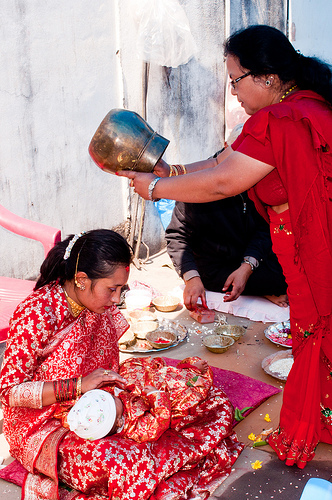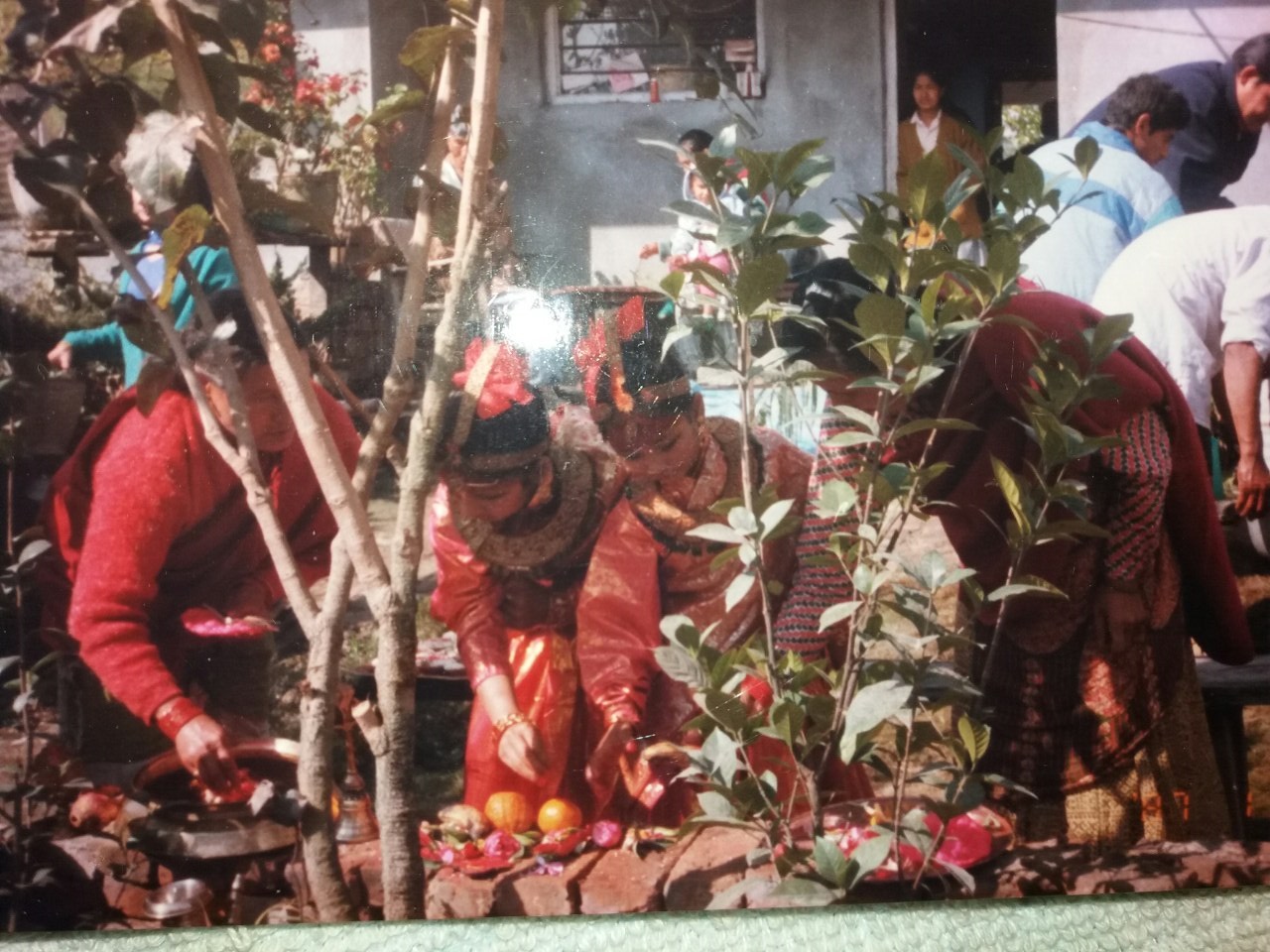Nepal, a beautifully intricate garden of over a hundred different ethnic groups, also naturally has countless numbers of unique traditions. Though trekking in Nepal is a major attraction for tourists, culture and traditional attractions are also strong attraction factors. Some traditions stem from ancient religious origins while some are specific to only one ethnic community. The list of customs and traditions in Nepal is so long and diverse that one could write a whole book about it. We are excited to showcase some interesting and unique traditions in Nepal related to major life events such as birth, adolescence, marriage, old age, and death. We are excited to showcase some interesting and unique traditions in Nepal related to major life events such as birth, adolescence, marriage, old age, and death:-
Nuwaran (Name-giving ceremony)
Originating from Hindu beliefs, Nuwaran is a child naming ceremony celebrated after 8th(for girls) and 9th(for boys) days of birth. During Nuwaran, according to the date and time of birth as well as the alignment of stars, an astrologer determines an auspicious starting letter for the child’s birth name along with the length of the name. The child’s birth name is necessary for rituals and pujas and it is usually not the name by which the child is known.
An interesting naming ceremony occurs in Sherpa communities as children are often named after the day on which they were born. Thus, a baby born on Thursday(symbol of Jupiter) would be called ‘Phurba’. In addition, the Sherpa children are also given virtue names such as Dorje(wisdom. The day names are often prefixed to the virtue names such as ‘Phu-Dorje’(Jupiter wisdom).
Pasni (Rice feeding ceremony)
Pasni is a ceremony celebrated for the first time a child is fed rice pudding. It is the first time when an infant is fed food other than mother’s milk. It signifies the growth of the infant to the next life stage. It is celebrated on different dates for daughters and sons as Pasni for daughters is celebrated in the 5th month and for boys in 6th month after their birth.

Bratabandha
Bratabandha is a ceremony to signify the transition from boyhood into manhood. It is such an important ritual that a man cannot marry until he has performed bratabandha. During the ceremony, the boy’s head is shaved and various rituals are conducted. The rituals in Bratabandha varies from community to community. In Hindu communities, rituals during the Bratabandha represent the banishment of the boy(symbolization of Lord Ram’s exile)whereas, in Buddhist communities, the rituals represent the abandonment of worldly pleasures by the boy and transition into a monk(symbolization of Buddha’s retreat from worldly pleasures).
Bel Bibaha
Every newari woman goes through three different marriage rituals in her lifetime; Bel Bibaha(marriage with wood apple), Bahra ceremony(marriage with the sun) and marriage with a boy.
Bel Bibaha or commonly known as ‘Iha’ is a ceremony in Newar community in which pre-adolescent girls are married to wood apple fruit. The wood apple fruit is a symbol for Lord Kumar, son of Lord Shiva(one of the most divine deities in Hinduism) as a bridegroom. The significance of this ritual is to ensure that the girl remains chaste and fertile for the rest of her life. She will also be sheltered in case her real husband dies as she is considered to be married to Lord Kumar and not considered a widow.
Bahra ceremony
Bahra ceremony, popularly known as ‘Gufa rakhne’ or sun marriage is a ceremony for girls around the period of first menstruation. Though there are many variants of this ceremony, generally a girl is hidden in a room where no sunlight can penetrate and she is not allowed to see any male’s face for 12 days. A voodoo doll representing Bahra Khayak(Cave ghost) is also put in one corner of the room which the girl regularly worships. At the end of the 12 days, she is given a bath to purify herself and she is adorned in a traditional wedding dress. After an elaborate ritual, a priest weds the girl with the sun showing her the reflection of the sun from a mirror to signify the end of Gufa and beginning of her womanhood.

Chori Bibaha(Marriage by kidnapping)
Chori Bibaha is a traditional marriage ritual observed in the Tamang communities. This ritual usually occurs when the bride may not consent easily or if a boy wants to avoid long procedures of an arranged marriage. A girl is usually captured from a fair or a market by a boy. After capture, if the girl persistently refuses to get married for three days then she is allowed to return to her parents. If she consents, a proper wedding ceremony is organized. In recent times, this ritual is rarely observed as modernization and laws against kidnapping are enforced.
Janku
Janku is a celebration of life when one reaches a certain age. There are five total janku celebrations; 77 years, 1000 months old(roughly between 81-84 years), 88 years, 99 years and 110 years old. The common quality in all of the janku celebrations is that the man or woman is treated like a bridegroom or bride, dressed lavishly and paraded around the city in chariots visiting different temples and vihars.
The significance of this celebration is related to Newari texts which mention that ‘the Janku celebration ages marks inauspicious times in a person’s life when even the smallest threat may pose a serious threat to one’s life’. The various Janku rituals are performed to please the gods and help one overcome these problems. In ancient times, the average life expectancy of a person was only 67 years so when someone reached a Janku aged, it was like they were given a new life. After the second janku, the person is given the ‘Thakali’ status and given respect equal to gods or goddesses.

Sky burial
Sky burial is a unique method of funeral practice observed in the mountainous highlands such as Upper Mustang and Dolpa in Nepal. The corpse is left in specific sky burial designated sites to be eaten by scavenging birds and animals such as vultures, Himalayan Griffons, Lammergeier, etc. In Tibetan tradition, it is believed that it is not necessary to preserve the corpse as it is only an empty vessel. In highlands, as the ground is too rocky and there is a lack of decomposers for ground burial along with a scarcity of fuel and timber for cremation, sky burial is the most reasonable option.
These are only some of the interesting rituals and customs of Nepal. Nepal is just as rich in traditional and cultural heritage as it is rich in natural resources and mountains. A trip to experience the ancient culture and tradition of Nepal will be just as memorable and fulfilling as a trek to the Himalayas.








